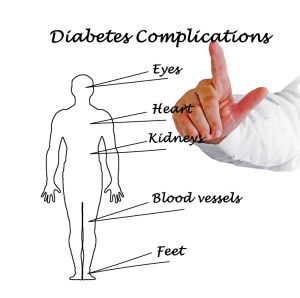Uncontrolled diabetes leads to complications of diabetes like damage to the lining of the arteries in all the key organs, which is what causes the complications of diabetes: kidney damage (nephropathy), eye damage (retinopathy), brain and nerve damage (neuropathy), as well as heart attacks and strokes (vascular damage).
Diabetic Nephropathy
This type of kidney damage is due to small blood vessel disease from uncontrolled diabetes, which leads to decreased kidney function. Diabetic nephropathy develops when the hemoglobin A1C level has been more than 7% for a number of years. When diabetes control has been poor, irreparable kidney damage is caused in the filtration units, called glomeruli.
Eventually this will result in the need for kidney dialysis or a kidney transplant. On the other hand management of diabetes with a hemoglobin A1C of less than 7% will usually prevent this from happening. Also, the ACE inhibitor drugs captopril (brand name: Capoten) and enalapril (brand name: Vasotec) can be used to repair some of the glomeruli micro-damage to a large extend and also help reduce high blood pressure.
Diabetic Retinopathy
The eye damage from uncontrolled diabetes is called diabetic retinopathy. The retina of the eyes is another area where changes to the blood vessels are immediately detectable. The eye-specialist can see changes in the blood vessels long before they lead to complications such as swelling of the retina (= macular edema), proliferative changes, retinal detachment or retinal hemorrhage. Diabetic retinopathy from uncontrolled diabetes is one of the many causes of blindness. Again, it cannot be emphasized enough how important it is to control the blood sugars tightly with hemoglobin A1C values of less than 7%, as blindness from diabetes is preventable.
Diabetic Neuropathy
Nerve damage from diabetes is called diabetic neuropathy. When the small nutritional arteries that supply the nerves in the body with nutrients, get damaged from arteriosclerotic disease due to uncontrolled diabetes, neuropathy damage is noted in various parts of the nervous system:
- polyneuropathy: when sensory nerves are affected there is often a glove stocking distribution of loss of feeling in both hands and both feet. This can lead to such things as unexpected burns or pressure ulcers, because the patient did not feel a pebble in the shoe. However, when the diabetic foot ulcer is being treated, it becomes often apparent that there is poor foot circulation because of severe occlusive arterial disease beyond repair and a foot amputation may have to be considered. Another manifestation of polyneuropathy may be shooting pains or severe deep seated gnawing pains in an affected extremity.
- mononeuropathy: this is an acute, painful condition where the blood supply to a nerve is suddenly interrupted due to a nerve infarction. This happens more often one of the 12 cranial nerves
in the head area and in the femoral nerve of the leg. - autonomic neuropathy: the autonomic nervous system (the sympathetic and parasympathetic nerve fibers throughout the body) is very sensitive to elevated blood sugars from diabetes and damage to it is called autonomic neuropathy. When the autonomic nervous system is affected by a neuropathy, then a variety of body functions such as the heart rate and digestive system function, which normally are automatically regulated, are in disarray. The complaints span from impotence in males to sudden low blood pressure with dizziness on standing up, to delayed emptying of the stomach and bladder dysfunction. Bowel activity can be changed with development of diarrhea or change to constipation. Nocturnal diarrhea can be very frustrating and interfere with a normal sleeping pattern. The cardiovascular system can also be affected.
Vascular Complications
Diabetes also affects the blood vessels. As already discussed small blood vessels are damaged by poor control of blood sugars. But the larger blood vessels are also affected by diabetes and a severe acceleration of arteriosclerosis occurs in diabetics who do not control their blood sugars. Doctors call this”macrovascular disease“.
This leads to circulation problems in the brain (strokes) and in the heart (heart attacks, serious arrhythmias and congestive heart failure). Unfortunately serious circulation problems result from this usually in the lower extremities, where circulation normally is not as good as in the upper extremities due to gravity (Ref. 7). The worst combination of circumstances exists in a person who is a heavy smoker and who also had uncontrolled diabetes for a number of years. Such a person has a high probability of developing Buerger’s disease (narrowing of the smaller and midsize arteries of both legs from smoking) and superimposed severe arteriosclerosis of the larger vessels in both legs as well due to the uncontrolled diabetes. Frequently this leads to amputations of a part or of the whole lower extremity on one or both sides.
References:
1. MT Kailasam et al. J Hypertens 2000 Nov 18(11): 1611-1620.
2. G Chinetti et al. Inflamm Res 2000 Oct 49(10): 497-505.
3. St. Paul’s 46th Annual Cont. Med. Educ. Course for Prim. Phys., Nov. 14-17, 2000. Dr. David Thompson, Div. of Endocr., Vancouver Hosp. and UBC.
4. B J Goldstein Int J Int Pract 2000 Jun 54(5): 333- 337.
5. M Maghnie et al. N Engl J Med 2000 Oct 5;343(14): 998-1007.
6. E Albertazzi et al. J Am Soc Nephrol 2000 Jun 11(6):1033-1043.
7. M Funk et al. American Journal of Emergency Medicine Vol.19,No.6, Oct.2001, W. B. Saunders Company
8. Ferri: Ferri’s Clinical Advisor: Instant Diagnosis and Treatment, 2004 ed., Copyright © 2004 Mosby, Inc.
9. Rakel: Conn’s Current Therapy 2004, 56th ed., Copyright © 2004 Elsevier
10. The 50th Annual St. Paul’s Hospital Continuing Medical Education Conference for Primary Physicians, Nov. 16 – 19, 2004
11. Suzanne Somers: “Breakthrough” Eight Steps to Wellness– Life-altering Secrets from Today’s Cutting-edge Doctors”, Crown Publishers, 2008







